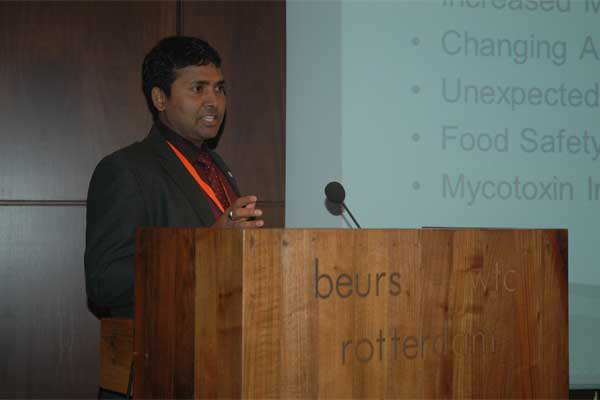Alltech’s three ways to manage mycotoxins

More than 450 industry professionals attended the World Mycotoxin Forum in Rotterdam, Netherlands, recently to discuss the latest technologies in the field of mold and mycotoxins.
The conference brought together some of the greatest leaders in the field of mycotoxin management with the ultimate goal of bringing new, innovative solutions to the increasing challenge of mycotoxins.
In his presentation, Dr. Swamy Haladi, global technical director for Alltech’s Mycotoxin Management Team, proposed a three-pronged approach to managing mycotoxins and encouraged attendees to take ‘A New Look at Mycotoxin Management: Holistic Approach.’
“First, diagnose the issue using the 37+ Program, where more than 37 mycotoxins can be analyzed in a single run. This programme was used to analyze European and North American feedstuffs and indicated the presence of one or more mycotoxins in 88% of the EU samples tested and two to five mycotoxins in 83% of the US samples tested this autumn,” said Haladi.
Haladi added that 50% of the samples contained three or more mycotoxins, which can present a very real concern to producers during this tough economic time. “Although it’s not always easy to estimate the impact of mycotoxicoses in the field, countless controlled studies have shown the impact mycotoxins can have on economic parameters such as weight gain, egg/milk production, feed efficiency, fertility, hatchability and mortality,” Haladi said.
The second step in Haladi’s approach is the implementation of Alltech’s MIKO Program. MIKO is based on HACCP principles and primarily involves the evaluation of critical points of entry of mycotoxins into animal feeds and their timely prevention and control.
Haladi concluded that the third prong should include the research and development of broad spectrum mycotoxin binders capable of adsorbing many mycotoxins of significance to the animal industry.
“Our livestock remains the best indicator of a mycotoxin presence,” Haladi said. “If an animal is not performing to its fullest, or unexplained symptoms persist, consider the role that a mycotoxin may be playing.”
For more information about the 37+ Program visit www.mycotoxinmanagement.com











